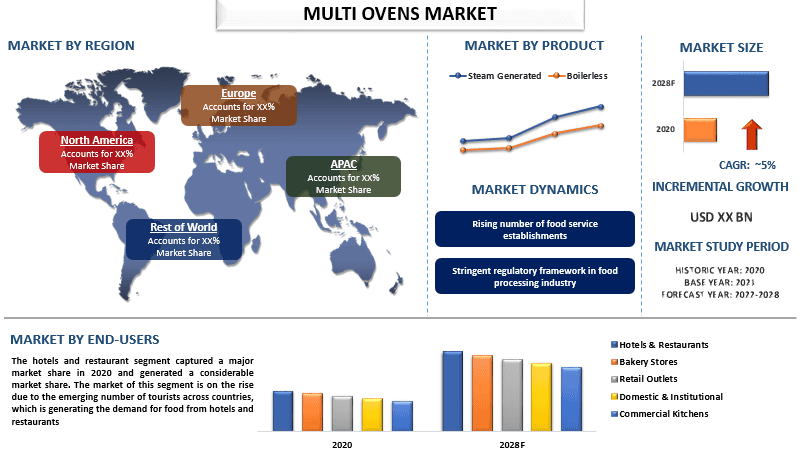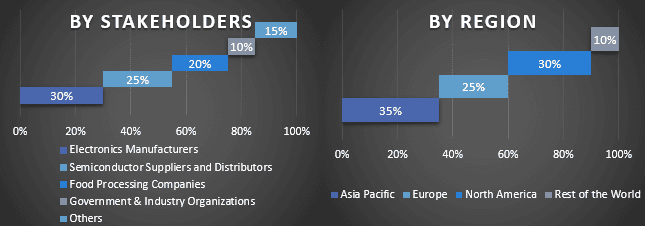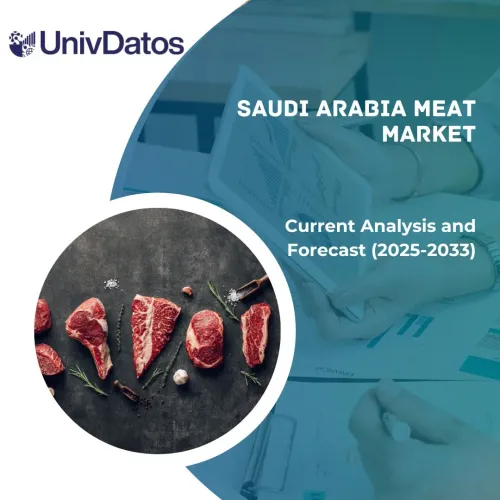- Inicio
- Acerca de nosotros
- Industria
- Servicios
- Leyendo
- Contáctenos
Mercado de hornos múltiples: análisis actual y pronóstico (2022-2028)
Énfasis en el producto (Generado por vapor y sin caldera); Usuarios finales (Hoteles y restaurantes, Panaderías, Puntos de venta minoristas, Doméstico e institucional, Cocinas comerciales); y Región/País

Se espera que el mercado mundial de hornos múltiples crezca a una tasa significativa de alrededor del 5% durante el período previsto. El aumento del gasto per cápita de los consumidores en alimentos en todo el mundo los ha inclinado hacia modos de cocción rápidos, convenientes y saludables que requieren menos tiempo de limpieza, lo que contribuye al crecimiento del mercado de hornos múltiples. Por ejemplo, en 2019, Japón tiene el gasto per cápita más alto en alimentos, que es de USD 4417,5 por persona, seguido de Australia, Canadá y Francia con un gasto por persona de USD 3003,6, USD 2986,9 y USD 2983,4, respectivamente. Esto ha supuesto una necesidad creciente de equipos de cocina, incluidos los hornos múltiples, en restaurantes, cafeterías y hoteles, así como para uso residencial. Por lo tanto, impulsa el mercado de equipos de cocina comerciales.
Además, los alimentos procesados ocupan una parte importante de muchas dietas en todo el mundo, ya que están ampliamente disponibles, son baratos y se comercializan intensamente. La demanda de hornos múltiples está aumentando drásticamente en todo el mundo debido al creciente consumo de alimentos procesados en muchos países de altos ingresos, lo que lleva al aumento de las ventas de alimentos procesados y envasados. Por ejemplo, las ventas de alimentos envasados en todo el mundo fueron de casi USD 2339,7 mil millones en 2015 y aumentaron gradualmente a USD 2578,9 mil millones en 2017 y USD 2644,1 mil millones en 2019. Además, el avance en las tecnologías utilizadas en la fabricación de alimentos y bebidas para mantener y prolongar la vida útil de los productos para mejorar la calidad de los alimentos también está impulsando el crecimiento del mercado.
General Electric, Whirlpool Corporation, AB Electrolux, Robert Bosch GmbH, Siemens AG, Samsung Electronics, Midea Group, Haier Group Corporation, Panasonic Holdings Corporation y Breville son algunos de los actores clave en el mercado. Estos actores han emprendido varias fusiones y adquisiciones junto con asociaciones para facilitar a los clientes productos/tecnologías innovadores y de alta tecnología.
Perspectivas presentadas en el informe
"Entre los productos, se prevé que la categoría de generación de vapor sea testigo de una TCAC más alta durante el período de pronóstico"
Según el producto, el mercado se segmenta en generación de vapor y sin caldera. Se espera que la categoría de generación de vapor sea testigo de una TCAC más alta durante el período de pronóstico. Los hornos de vapor empujan el vapor de un tanque de agua calentada al horno para cocinar los alimentos, renunciando al aire caliente tradicional utilizado en los hornos de convección comunes. La mayor ventaja de estos hornos son sus técnicas de cocción saludables. En general, cocinar al vapor es una alternativa más saludable que hornear o freír. Además, la cocción al vapor resalta los colores, sabores y texturas naturales de un plato sin reducir su valor nutricional.
"Entre los usuarios finales, los hoteles y restaurantes tendrán una participación significativa en el mercado en 2020"
Sobre la base de los usuarios finales, el mercado se clasifica como Hoteles y restaurantes, Panaderías, Puntos de venta minorista, Domésticos e institucionales y Cocinas comerciales. Entre estos, el segmento de hoteles y restaurantes tendrá una participación significativa en el mercado en 2020. Esto se debe principalmente a que el sector de la hostelería emergente, a nivel mundial, es una de las razones principales que impulsan el mercado de equipos de cocina comerciales. Según el Banco Mundial, el número de salidas internacionales se duplicó con creces entre 1997 y 2017, de 687 millones a 1570 millones por año. Además, el número de habitaciones de hotel a nivel mundial había aumentado un 17,7% desde 2008 a 17 millones en 2018.
"Asia Pacífico tendrá una participación significativa en el mercado"
En 2020, Asia Pacífico tuvo una participación significativa en el mercado mundial de hornos múltiples. Un aumento en los cafés, hoteles y restaurantes en toda la región junto con la creciente demanda de alimentos procesados y envasados debido al creciente número de parejas trabajadoras y la adopción de la cultura occidental está conduciendo a la creciente demanda del mercado de hornos múltiples. Además, el crecimiento de la industria de viajes y turismo y el creciente atractivo de los restaurantes de servicio rápido (QSR) entre los millennials. Según Statista, el número de establecimientos de servicio de alimentos en todo el mundo varió mucho según la región en 2020. Asia-Pacífico tenía la mayor cantidad de establecimientos con más de 17 millones. En comparación, la región con el segundo número más alto de establecimientos de servicio de alimentos fue América Latina con más de 2,3 millones.
Razones para comprar este informe:
- El estudio incluye el tamaño del mercado y el análisis de pronóstico validado por expertos clave autenticados de la industria.
- El informe presenta una revisión rápida del desempeño general de la industria de un vistazo.
- El informe cubre un análisis en profundidad de los pares prominentes de la industria con un enfoque principal en las finanzas comerciales clave, la cartera de productos, las estrategias de expansión y los desarrollos recientes.
- Examen detallado de los impulsores, restricciones, tendencias clave y oportunidades que prevalecen en la industria.
- El estudio cubre exhaustivamente el mercado en diferentes segmentos.
- Análisis profundo a nivel regional de la industria.
Opciones de personalización:
El mercado mundial de hornos múltiples se puede personalizar aún más según los requisitos o cualquier otro segmento de mercado. Además de esto, UMI entiende que puede tener sus propias necesidades comerciales, por lo tanto, no dude en conectarse con nosotros para obtener un informe que se adapte completamente a sus requisitos.
Tabla de contenido
Metodología de investigación para el análisis del mercado de hornos múltiples (2022-2028)
El análisis del mercado histórico, la estimación del mercado actual y la previsión del mercado futuro del mercado mundial de hornos múltiples fueron los tres pasos principales que se llevaron a cabo para crear y analizar la adopción de hornos múltiples en las principales regiones del mundo. Se llevó a cabo una exhaustiva investigación secundaria para recopilar las cifras históricas del mercado y estimar el tamaño actual del mercado. En segundo lugar, para validar estos conocimientos, se tuvieron en cuenta numerosos hallazgos y supuestos. Además, también se realizaron exhaustivas entrevistas primarias con expertos de la industria en toda la cadena de valor del mercado mundial de hornos múltiples. Tras la asunción y validación de las cifras del mercado a través de entrevistas primarias, empleamos un enfoque de arriba hacia abajo/de abajo hacia arriba para pronosticar el tamaño total del mercado. Posteriormente, se adoptaron métodos de desglose del mercado y de triangulación de datos para estimar y analizar el tamaño del mercado de los segmentos y subsegmentos a los que pertenece la industria. La metodología detallada se explica a continuación:
Análisis del tamaño del mercado histórico
Paso 1: Estudio en profundidad de fuentes secundarias:
Se llevó a cabo un estudio secundario detallado para obtener el tamaño histórico del mercado de hornos múltiples a través de fuentes internas de la empresa, como informes anuales y estados financieros, presentaciones de resultados, comunicados de prensa, etc., y fuentes externas, como revistas, noticias y artículos, publicaciones gubernamentales, publicaciones de la competencia, informes del sector, bases de datos de terceros y otras publicaciones creíbles.
Paso 2: Segmentación del mercado:
Después de obtener el tamaño histórico del mercado de hornos múltiples, llevamos a cabo un análisis secundario detallado para recopilar información histórica del mercado y compartirla para diferentes segmentos y subsegmentos de las principales regiones. Los principales segmentos incluidos en el informe son el producto y los usuarios finales. Además, se realizaron análisis a nivel de país para evaluar la adopción general de modelos de prueba en esa región.
Paso 3: Análisis de factores:
Después de adquirir el tamaño histórico del mercado de los diferentes segmentos y subsegmentos, llevamos a cabo un análisis de factores detallado para estimar el tamaño actual del mercado de hornos múltiples. Además, llevamos a cabo un análisis de factores utilizando variables dependientes e independientes, como el producto y los usuarios finales de los hornos múltiples. Se llevó a cabo un análisis exhaustivo de los escenarios de demanda y oferta teniendo en cuenta las principales asociaciones, fusiones y adquisiciones, la expansión empresarial y los lanzamientos de productos en el mercado de hornos múltiples en todo el mundo.
Estimación y previsión del tamaño actual del mercado
Tamaño actual del mercado: Basándonos en la información práctica de los 3 pasos anteriores, llegamos al tamaño actual del mercado, los actores clave en el mercado mundial de hornos múltiples y las cuotas de mercado de los segmentos. Todos los porcentajes de participación, la división y el desglose del mercado requeridos se determinaron utilizando el enfoque secundario mencionado anteriormente y se verificaron mediante entrevistas primarias.
Estimación y previsión: Para la estimación y previsión del mercado, se asignaron ponderaciones a diferentes factores, incluidos los impulsores y las tendencias, las restricciones y las oportunidades disponibles para las partes interesadas. Después de analizar estos factores, se aplicaron técnicas de previsión relevantes, es decir, el enfoque de arriba hacia abajo/de abajo hacia arriba, para llegar a la previsión del mercado para 2028 para diferentes segmentos y subsegmentos en los principales mercados a nivel mundial. La metodología de investigación adoptada para estimar el tamaño del mercado abarca:
- El tamaño del mercado de la industria, en términos de ingresos (USD) y la tasa de adopción del mercado de hornos múltiples en los principales mercados nacionales
- Todos los porcentajes de participación, divisiones y desgloses de los segmentos y subsegmentos del mercado
- Actores clave en el mercado mundial de hornos múltiples en términos de productos ofrecidos. Además, las estrategias de crecimiento adoptadas por estos actores para competir en el mercado de rápido crecimiento
Validación del tamaño y la cuota de mercado
Investigación primaria: Se realizaron entrevistas en profundidad con los líderes de opinión clave (KOL), incluidos los ejecutivos de alto nivel (CXO/VP, jefe de ventas, jefe de marketing, jefe de operaciones, jefe regional, jefe de país, etc.) en las principales regiones. Los hallazgos de la investigación primaria se resumieron y se realizó un análisis estadístico para probar la hipótesis establecida. Los aportes de la investigación primaria se consolidaron con los hallazgos secundarios, convirtiendo así la información en conocimientos prácticos.
División de los participantes primarios en diferentes regiones

Ingeniería de mercado
Se empleó la técnica de triangulación de datos para completar la estimación general del mercado y para llegar a números estadísticos precisos para cada segmento y subsegmento del mercado mundial de hornos múltiples. Los datos se dividieron en varios segmentos y subsegmentos después de estudiar varios parámetros y tendencias en el producto y el usuario final en el mercado mundial de hornos múltiples.
El objetivo principal del estudio del mercado mundial de hornos múltiples
Las tendencias actuales y futuras del mercado mundial de hornos múltiples se señalaron en el estudio. Los inversores pueden obtener información estratégica para basar su criterio para las inversiones en el análisis cualitativo y cuantitativo realizado en el estudio. Las tendencias actuales y futuras del mercado determinaron el atractivo general del mercado a nivel regional, lo que proporciona una plataforma para que el participante industrial explote el mercado sin explotar para beneficiarse de una ventaja de ser el primero en actuar. Otros objetivos cuantitativos de los estudios incluyen:
- Analizar el tamaño actual y previsto del mercado de hornos múltiples en términos de valor (USD). Además, analizar el tamaño actual y previsto del mercado de diferentes segmentos y subsegmentos
- Los segmentos en el estudio incluyen áreas de producto y usuario final.
- Definir y analizar el marco regulatorio para los hornos múltiples
- Analizar la cadena de valor involucrada con la presencia de varios intermediarios, junto con el análisis del comportamiento de los clientes y la competencia de la industria.
- Analizar el tamaño actual y previsto del mercado de hornos múltiples para la región principal.
- Los principales países de las regiones estudiadas en el informe incluyen Asia Pacífico, Europa, América del Norte y el resto del mundo.
- Perfiles de empresas del mercado de hornos múltiples y las estrategias de crecimiento adoptadas por los actores del mercado para mantenerse en el mercado de rápido crecimiento
- Análisis regional profundo de la industria
Relacionados Informes
Los clientes que compraron este artículo también compraron










